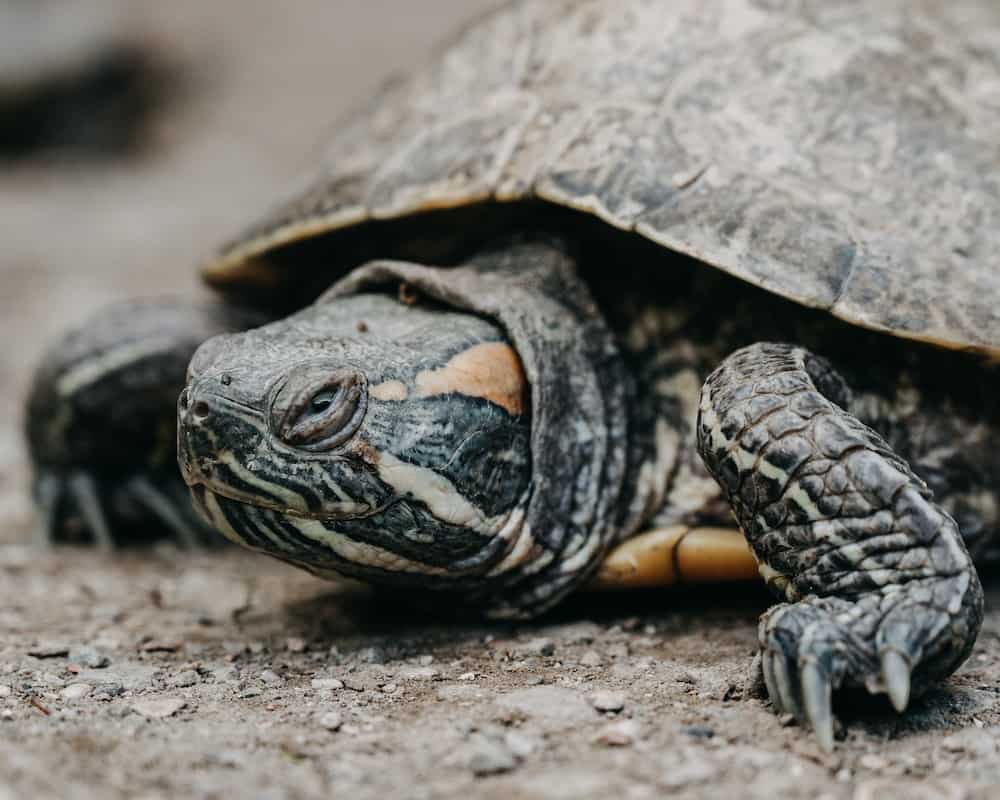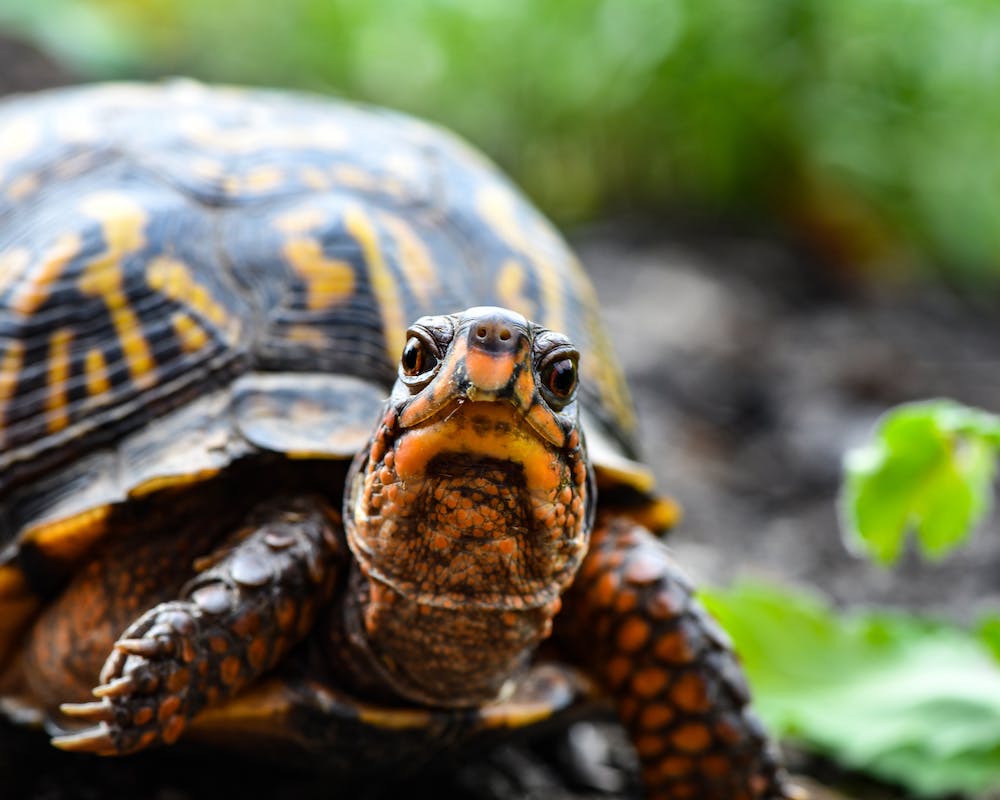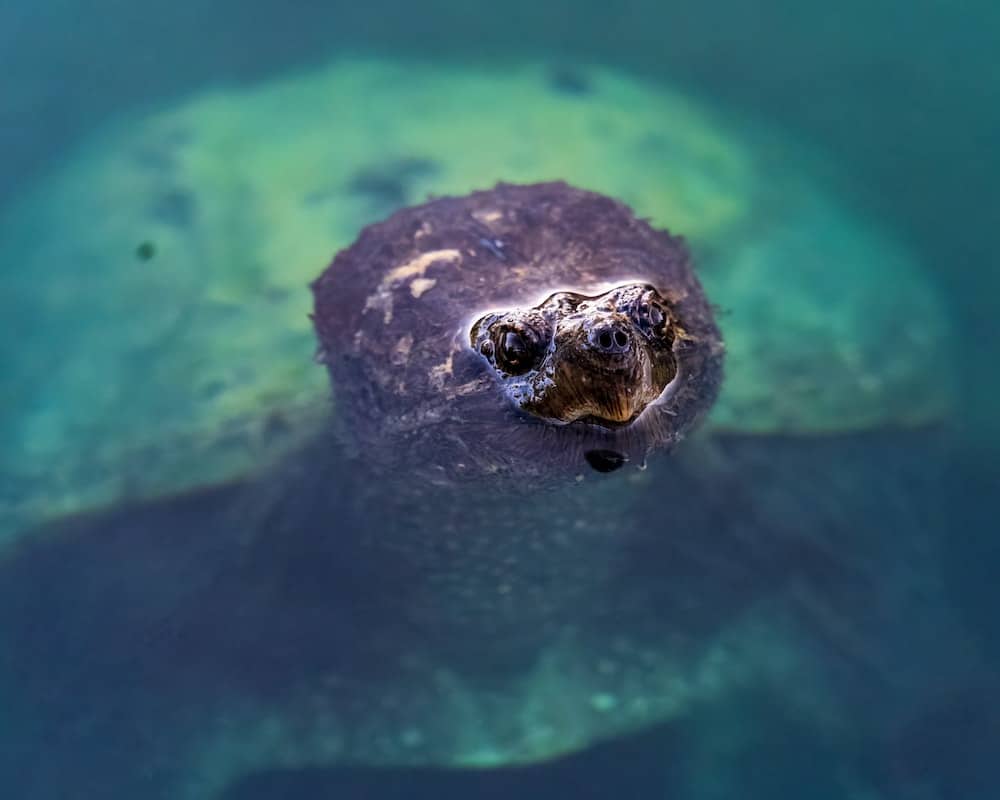A turtle can have white spots on its shell due to multiple factors. The reasons can be mineral deposits on the shell, shell rot caused by bacterial or fungal infections or injury, or shedding of scutes and skin.
Are you eager to learn more about why white spots appear on turtle shells and what you should do?
What is a Turtle Shell Made of?
A turtle’s shell is incredibly hard and consists mainly of two parts: a carapace and a plastron. Carapace is the hard outer dome-shaped shell of a turtle. It is made up of flat and broad ribs and backbone. Since the carapace is made of bones, it is susceptible to breaking and injury like human bones.
The carapace is also covered with scutes. Scutes is a layer of protection for the carapace made of keratin. Most aquatic turtles can shed their scutes.
Plastron is the posterior part of the turtle’s shell. It is also made of bones, but it is usually flat. A bridge connects the carapace and plastron.
Note: Turtles can also get a white film over their eyes, this is a natural translucent film called a nictitating membrane, not related to the white spots on a turtles shell.
Reasons for White Spots on the Carapace of a Turtle
Here are some of the common reasons for white spots might appear on a turtle’s shell:
- Deposition of Minerals
Your pet turtle may have a whitish and chalky look on its shell due to deposits of minerals formed. This can occur because of hard water in the pet enclosure.
Hard water contains substances like calcium carbonate and magnesium. These substances could be responsible for forming a whitish layer on your turtle’s carapace.
Usually, mineral deposits will be formed over large patches on your turtle’s shell rather than small white spots. The formation of deposits due to hard water is not a sign to worry about. Below are two simple tests that’ll help you confirm the deposition of minerals:
- To confirm whether the spotted white formation is due to mineral deposits, monitor your turtle for other signs of illness, weakness, or injury. If your turtle is not displaying any other symptoms, the white spots are due to calcium carbonate and mineral deposits.
- Another test to verify it is to add a drop of plain white vinegar to the white patch. If the spot fizzes out, it is a clear indication that the spot was due to a mineral deposit. However, avoid using this test if your pet turtle demonstrates any other symptoms, as the vinegar may sting it.
- Rotting of Shell Due to Infections
Shell rot could be another reason you notice white spots all over your turtle’s carapace. In the case of shell rot, you may observe small white patches or spots as opposed to large white patches, as was the case of mineral deposits.
Shell rot can be caused due to various reasons like bacterial or fungal infections. Fungal infections are caused mainly by poor environmental conditions. They can be caused by dirty water, poor UVB light, and unhygienic tank conditions. Warm water can also boost fungal growth.
Fungal infections are contagious and should be addressed immediately by seeking proper consultation from a vet.
Shell rot is a severe health condition. If left untreated, you may observe that the white spots are getting more prominent and can turn into symptoms like red patches, dents, pitting, and bleeding.
Shell rot is often caused by injuries, cracks in the turtle’s shell, and inappropriate and unhygienic tank conditions.
Injuries to the carapace may also be one of the underlying causes of shell rot which can lead to a formation of white spots. Injuries can occur due to low temperature and humidity conditions.
Other factors contributing to shell damage could be poor diet, sharp objects in the pet enclosure, or an injury caused due to a fight with another turtle housed in the same enclosure.
- Shedding of Scutes
Turtles belong to the reptile class in the animal kingdom, and like all reptiles, they tend to shed. Except in the case of turtles, the scutes or the outer keratin layer gets shed.
While shedding, the scutes get shed in thin peels of a white translucent layer. Sometimes these scutes do not get adequately shed, and that is why you may observe whitish spots or patches on your turtle’s carapace or outer shell.
Types Of Shell Rot in Turtles
There are two types of shell rot: dry rot and wet rot. Dry rot is related to fungal growth and can make the shell brittle. Usually, it can be seen as white or tan discoloration.
Wet rot shows white or yellow discoloration, spots, pits, and pus discharge. It is more severe than dry rot and must be addressed immediately.
When Should You Consult a Vet?
If the reason for the occurrence of white spots on your turtle’s carapace is shell rot, you must immediately consult a veterinary doctor. Shell rot can be fatal for your turtle if not addressed early.
If you see any signs like red spots, bleeding, or pus oozing out of your turtle’s shell, it is a clear indication to take it to a veterinary doctor immediately.
Shell rot can lead to septicemia. This means the virus or infectious pathogens affecting your turtle will enter their bodies through the shell. This can lead to the death of your pet turtle within a few days.
The infection can also enter the bloodstream and stay there for years if not attended. This can lead to many other complications that can damage your turtle’s internal organs. Prompt medical attention can prevent all these unnecessary complications.
However, it would be best if you didn’t try to treat your pet turtle at home as it may further worsen the condition.
How to Prevent White Spots on Your Turtle’s Shell?
Since the reasons for the appearance of white spots can be varied following are some preventive measures to avoid white spots caused by individual reasons:
- Prevention of White Spots Caused By Hard Water
Hard water is usually tap water containing minerals and calcium carbonate deposits. Though not harmful, it can lead to the formation of deposits on your turtle’s outer shell.
To prevent it, you can use distilled water in the tank. You may also use water that is treated using a water softener or water conditioner.
It is important to note that you do not change the entire hard water present in the tank all at once. This can give your pet an environmental shock. It is advisable to start replacing one-quarter of the hard water with treated water.
- Prevention of White Spots Caused By Infections
Most bacterial and fungal infections are caused by poor enclosure conditions. Turtles are semi-aquatic in nature. They will swim, eat, and contaminate the water that they are in. This leads to a poor tank environment.
To prevent shell rot caused by various fungal and bacterial infections, you must ensure that the pet enclosure is always clean and hygienic. You must change the tank water regularly. Fitting in a good filtration system also helps in keeping the tank clean.
- Prevention of White Spots Caused By Scutes
Shedding of scutes is a natural process for your turtle. However, sometimes, these scutes get retained, giving the appearance of white spots.
Giving your pet turtle a nice warm exposure to UVB light will aid in shedding. Keeping the basking area dry and hygienic also helps in preventing the retained scutes.
Ensuring that the pet enclosure has a good UVB light installed will prevent the formation of any scute formation due to a dry shell.
How to Remove White Spots Caused by Hard Water Deposits?
Though the white spots caused by hard water deposits are not harmful, they can make the turtle’s shell look patchy and chalky. Plus, the presence of these chalky patches can make it hard for you to detect other worrying symptoms like shell rot.
Therefore it is best to remove these hard water deposits. You can gently scrub the white stains with plain white vinegar and a soft cloth or sponge.
Alternatively, you can use a solution of apple cider vinegar and water and a gentle brush to scrub off the white stains and deposits.
If the mineral deposits, however, do not fizz up once you apply vinegar, do not continue this process. Start observing for other symptoms and seek proper medical care for your turtle.
Conclusion
White spots on your pet turtle’s carapace can occur due to a common harmless reason like hard water deposits or remnant dried scutes or due to a grave clinical condition like shell rot.
In the former case, you can try home remedies to make your turtle’s shell look shiny and normal. However, in the latter case, immediate medical attention is required.




